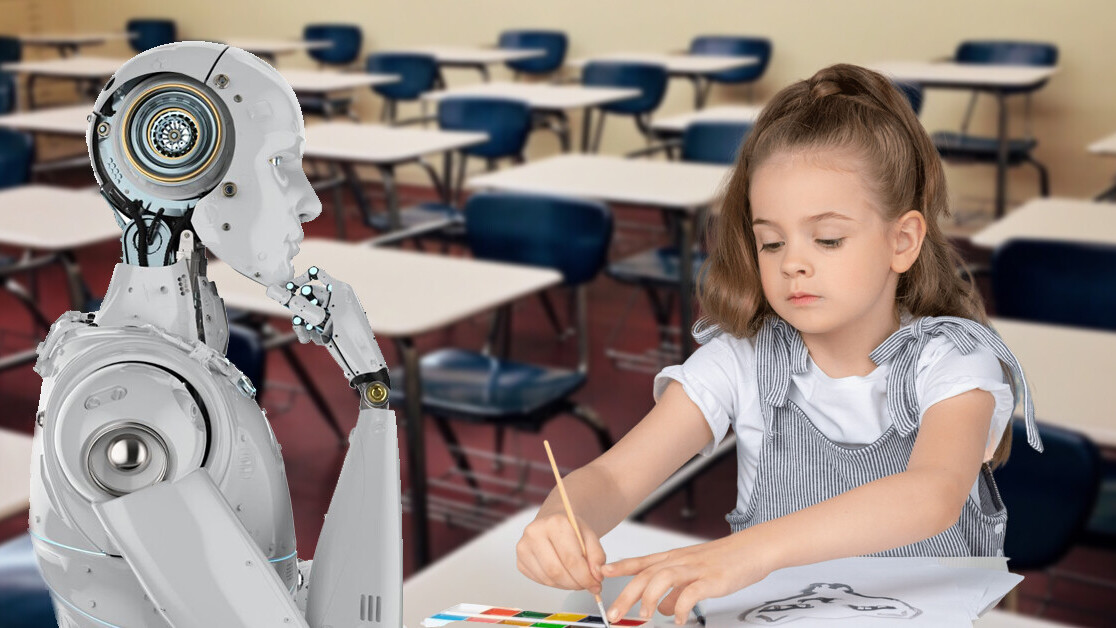
Did you know TNW Conference has a track fully dedicated to bringing the biggest names in tech to showcase inspiring talks from those driving the future of technology this year? Tim Leberecht, who authored this piece, is one of the speakers. Check out the full ‘Impact‘ program here.
At first glance, it is an unlikely match: on the one side, Augmented Reality/Virtual Reality (AR/VR), blockchain, Artificial Intelligence (AI), or neuro-computing — so-called “exponential technologies,” defined as technologies that develop exponentially fast, with power and speed doubling and cost dropping by half every year. On the other side, the pre-kindergarten kids enrolled in Head Start programs across the U.S. who benefit from early childhood education and comprehensive health and community services for the most vulnerable children and their families. Moonshots catapulting humanity into the next evolutionary chapter and efforts to promote school readiness for low-income children seem to present a stark contrast. But the two camps have more in common than one might expect — and they have a lot to learn from each other.
Disruption coming home
Fifty years ago, the birth of Head Start as part of President Johnson’s War on Poverty, was a disruptive innovation before that was even a buzzword. The work product of an interdisciplinary task force, the program was the first large-scale example of applied design thinking, and it has since produced a remarkable amount of, wait for it, “frugal innovation,” led by the practitioners, teachers, administrators, and parents in the field, and reached more than 30 million children, including one million each year. An in-depth understanding of “user” needs, a high degree of empathy, and strong ingenuity under tight constraints are Head Start’s characteristics, and those are the same qualities that are often now viewed as hallmarks of innovators.
The National Head Start Association (with which I have worked as a consultant for more than a year) recently launched the HeadStarter Network, an independent non-profit organization with the mission to connect the learnings and innovations from Head Start with forward-thinking education professionals and the tech industry in order to help create next-generation models for early childhood education.
The HeadStarter Network’s first-ever Tech and Early Ed Incubator, a two-day ideation challenge, took place in Austin last weekend. I joined 50 participants for an event that was part conference, part hackathon (without the coding part), with a panel of expert judges selecting a winning idea to be developed further with support from the HeadStarter Network and its partners.
The task at hand was two-fold: first, to generate ideas for incorporating exponential technologies in the classroom; and second, to examine how AR/VR, blockchain, AI, and the like can improve the effectiveness of early childhood education program management.
Read: [What science says about your kids’ tech habits]
Active experiences are key
Kids learn best from active engagement rather than the passive consumption of text and visuals. Augmented Reality (AR), which uses technology to inspire cognitive and physical activity, link virtual and real worlds, and stimulate play, can be combined with educational content to create an engaging immersive experience for kids.
The Incubator’s winning team developed an idea for an AR product, “Project Saf-AR-i”, which uses AR to make experiential learning accessible to more children. Saf-AR-I takes virtual visitors on a tour of Africa’s wildlife, using low-tech QR codes (which are cheaply available) as cues for overlaying the physical world with virtual objects and associated information. In a fun and tangible way, the app teaches lessons on math, literacy, and empathy.
Blockchain as the great equalizer
In terms of governance, effective data management is the perennial challenge of all early childhood education programs. Not only do data sets reside in disjointed, siloed databases that are burdensome to aggregate and analyze across diverse programs; children and their families also often inadvertently give up their personal information, with government or commercial platforms the only ones able to access and extract value from it. Along with the need to comply with increasingly rigid performance standards, it becomes obvious why the field has long been searching for a more efficient, integrated solution.
Enter blockchain, the underlying technology for Bitcoin and other crypto-currencies, which despite the current hype (and growing backlash), represents an intriguing new paradigm. As Incubator judge Caterina Rindi, an expert on blockchain for social impact, illustrated in her remarks, the inherent principles of blockchain — decentralized structure, an immutable record of data entries, radical transparency, and equal access for all contributors with no intermediary in the mix — can help ensure sovereign identities and thus empower teachers, administrators, and children alike.
Moreover, because of its decentralized structure, Blockchain can gather and open-source all data in one place, thereby allowing all stakeholders to gain aggregated insights. Eventually, this might enable users to recognize behavioral, demographic, or fiscal patterns, readily tweak elements of the program, and possibly even apply predictive analytics. Blockchain puts the data back into the hands of those who produce them and allows them to constantly innovate.
From AI to EI
AI is a promising way to link classroom and management needs. As adults, we’re already immersed in it, whether we realize it or not (from the fast-learning algorithms on Amazon to chatbots), but how exactly it can be used in the classroom was a challenge taken on by another Incubator team.
Named Tiny Moments.ai, the software application they proposed was designed to lower children’s levels of toxic stress, which is widely acknowledged as increasing the risk for future physical and mental health problems as well as potentially impairing children’s braincircuit formation. Tiny Moments would monitor the child’s classroom interactions, alert parents and teachers at peak stress moments, and, based on deep learning algorithms, identify key stressors as well as suggest effective counter-measures: those “tiny moments” that make a difference in the child’s experience and enhance his or her well-being.
The team argued that its solution would also ease the burden on teachers (by automating some of the reporting) and empower parents by giving them immediate insight into their child’s classroom experience. Think of it as Seesaw (the popular parent communications and classroom portfolio sharing app for parents) on steroids, powered by an AI engine.
The judges were impressed with the rigor and fidelity of the Tiny Moments concept, but worried about privacy issues, while also feeling uneasy about surveying the children’s emotional expressions. Furthermore, they flagged automated reporting as potentially depriving teachers of their agency. These concerns reflect those that are often expressed in response to AI solutions focused on optimization.
There are philosophical questions that can be raised, too: What if a more or less binary approach to stress reduced the emotional range of children and forced them into a happy medium? How can children learn to manage their emotions if they don’t experience the full range? And how exactly would an AI-powered platform distinguish toxic stress from the kind of positive or tolerable stress that might be beneficial for a child’s development? Is that a decision that can and should be delegated to machines?
Teaching humanity
The Tiny Moments concept pinpoints the fundamental tension in the relationship between early childhood education and exponential technology. While we want our kids to become tech literate, we are also facing the reality that it’s this very technology that might render them obsolete in the future automated workforce (“Will Robots Take Our Children’s Jobs?,” the New York Times wonders).
Early childhood education serves as a magnifying glass for the use of exponential technology: it can be the disease or the cure, or both, but a panacea it is not. It can humanize or dehumanize us, acerbate our vulnerabilities or enhance our strengths, derive us of agency, or empower us, reduce us to mere consumers or expand our humanity. There is still time to shape our future the way we want it, and we better start early.
As it becomes increasingly difficult or even impossible to regulate the enormous impact of exponential technologies, our hopes rest on the moral awareness of future generations, as much as their faith in a peaceful and prosperous society will rest on those very technologies.
Once today’s pre-K kids have entered the workforce, it will be normal for them to work side by side with co-bots (if there is still even a place for humans in the workforce), have AI embedded into all aspects of their lives, manage their personal data and identities on a blockchain, and traverse between virtual and real worlds via AR/VR applications. And who knows, they may even have already “fully merged” with machines.
To thrive in this brave new world, today’s children will certainly require advanced tech literacy, at least on a conceptual level (actual coding may, in fact, be done by AI and no longer require human intervention). Most importantly though, they will need strong socio-emotional skills to adapt to more dynamic and volatile relationships, heightened uncertainty, and ambiguous social environments, as well as to express and manage more fluid identities.
In the best-case scenario, I hope my own eight-year-old daughter will be able to use exponential technologies to live in more worlds with more identities and more meaning, as a gardener, artist, and healer, not just a tourist. But I also want her to grow up planting trees, writing songs, and playing her favorite imaginative game, “Animal Rescue Center,” with her stuffed animals (and the detailed records she keeps of both their ailments and treatment regimens). I want her to form an imagination rich enough to always strive for better tomorrows.
This article was originally published by Tim Leberecht, an author, entrepreneur, and the co-founder and co-CEO of The Business Romantic Society, a firm that helps organizations and individuals create transformative visions, stories, and experiences. Leberecht is also the co-founder and curator of the House of Beautiful Business, a global think tank and community with an annual gathering in Lisbon that brings together leaders and changemakers with the mission to humanize business in an age of machines.
Get the TNW newsletter
Get the most important tech news in your inbox each week.





